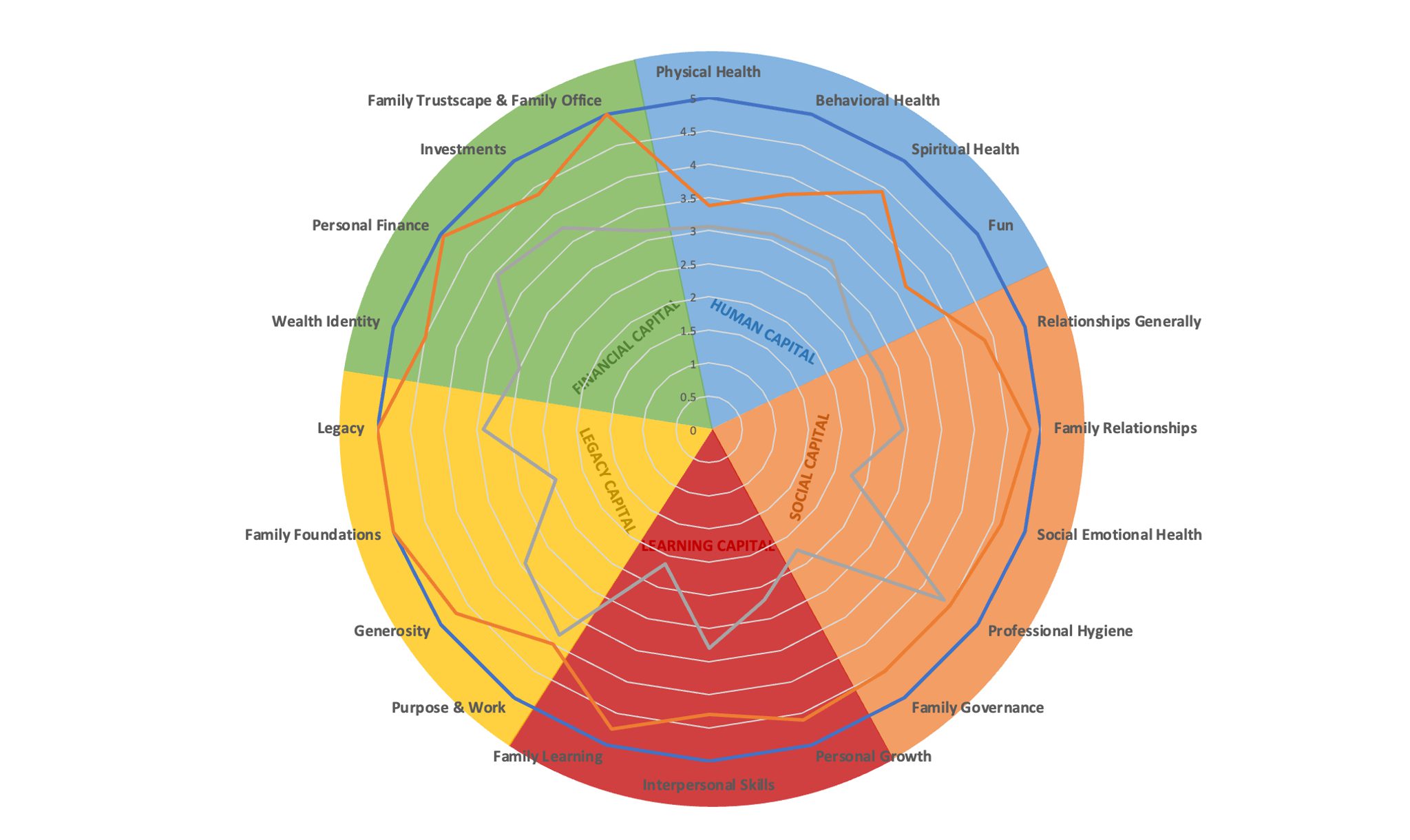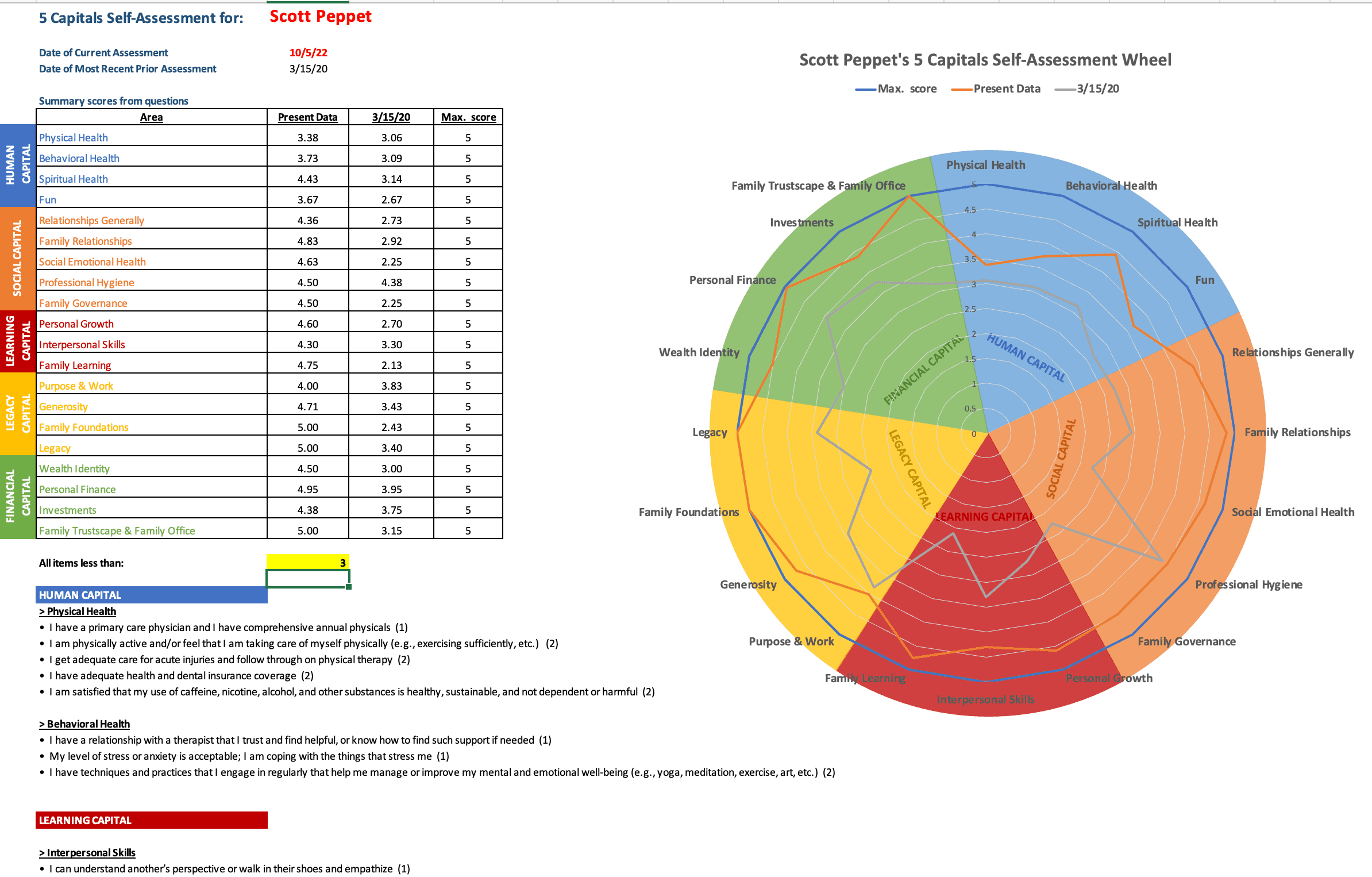Background on a 5 Capitals Framework
Following in the footsteps of Jay Hughes and others, I have long advocated for broadening our understanding of “wealth” to include intangible forms of capital beyond a family’s financial assets. (See, for example, my post on creating a 5- to 10- year, five capitals learning curriculum.)
In my work, I use the following formulation of the five capitals:![]()
- Human Capital: The mental, emotional, and physical well-being of the family. Is each family member flourishing?
- Learning Capital: The intellectual vitality and curiosity of the family. Is the family learning what it needs to succeed? (Sometimes called intellectual capital)
- Social Capital: The relationships both within and outside of the family. Does the family have strong relationships and decision-making?
- Legacy Capital: The family’s shared purpose and impact. Does the family preserve its history and grow its legacy into the future? (Sometimes called spiritual capital)
- Financial Capital: The family’s financial assets and integration of those assets. Does the family have a healthy relationship to financial capital and the ability to steward it?
One can define these forms of capital in many different ways–there is no “right” answer to how to do this. In my work, I have found this schema easy to explain and resonant for both family members and advisors. Using multiple capitals like this makes it easy for family members to understand that their goal is to grow the family’s “wealth” writ large–not just the family’s financial assets. One can contribute to the well-being of the family, to the family’s knowledge and learning, to strengthening relationships, and to the family’s philanthropic efforts or purpose–it all contributes to the growth of the family’s “capitals” over time.
A 5 Capitals Self-Assessment Tool
Here I offer a self-assessment tool designed to help an individual family member determine how they are personally doing in terms of each of these capitals. (I offer this tool freely under a Creative Commons BY NC SA 4.0 license that merely requires that anyone using or modifying the tool acknowledge its origins and not charge specifically for the use of the tool.)
- PDF Version: This is a paper version of the self-assessment, meant to be taken and scored on paper. If using this version, consider downloading the Excel version as well so that you can enter your (or another’s) results into the spreadsheet to generate an analysis report. (Download here)
- Excel Version: To use this spreadsheet requires a recent version of Excel (that can handle filter tables and other recent functions). The user answers all of the assessment questions and the spreadsheet then generates an analysis in the Final Report tab. As mentioned, one can also administer the questionnaire on paper and then merely enter the results into the spreadsheet to generate a report. (Download here)
In its current form, the assessment contains 180 questions broken into the following categories:
- Human Capital
- Physical Health (16 questions)
- Behavioral Health (11 questions)
- Spiritual Health (7 questions)
- Fun (3 questions)
- Social Capital
- Relationships Generally (11 questions)
- Relationships With Family (12 questions)
- Social Emotional (8 questions)
- Professional Hygiene (8 questions)
- Family Governance (4 questions)
- Learning Capital
- Personal Growth (10 questions)
- Interpersonal Skills (10 questions)
- Family Learning (8 questions)
- Legacy Capital
- Purpose & Work (6 questions)
- Generosity (7 questions)
- Family Foundations (7 questions)
- Legacy (5 questions)
- Financial Capital
- Wealth Identity (10 questions)
- Personal Finance (22 questions)
- Investments (8 questions)
- Family Trustscape & Family Office (13 questions)
The user inputs an answer for each question on a scale from 1 to 5, where one represents “Disagree” and five represents “Agree.” A user can also enter a comparison set of results from a prior administration of the assessment (e.g., results from a year prior). Those results will then be compared to the current inputs.
Once all values are entered, the spreadsheet dynamically creates a report similar to the following, containing a summary table of results, a self-assessment “wheel,” and a list of all items for which the user’s answer was below a given threshold (e.g., all answers where the person entered below a 3).
This shows the user both summary information about the various categories and subcategories of answers (in the table and wheel), but also item by item individual answers that were of concern.
Using The Assessment
This assessment was developed to be used individually as a self-check on one’s personal development. Many families and advisors have asked me what it means at a practical level to use the 5 capitals. The assessment is one way to answer that question, or to make the intangible capitals more real. It allows a person to really think through how they are doing in each of these five areas of life.
I imagine that some families may want to use the assessment in a group setting to show each person their individual results and then compare results across a family. This is certainly doable, although I have some doubts about whether individual family members will be willing to disclose such personal information to others. The goal of this assessment is to help an individual gain a nuanced, detailed picture of where they stand with the five capitals. To use it in a group setting would require very serious attention to issues of privacy and confidentiality.
Modifying The Assessment
Finally, a note on modifying the assessment. I have made it relatively easy for an administrator to alter the Excel spreadsheet in order to make changes to the following things in the assessment: (1) the names of the 5 capitals (e.g., if one wanted to change “Learning Capital” to “Intellectual Capital”); (2) any of the sub-categories (e.g., “Physical health”); (3) any of the individual questions. In the spreadsheet, there is an Instructions for Administrators tab on which one can make these changes. There are limits, however, to how malleable the Excel version can be — the number of capitals (5) is fixed; the number of questions in each sub-category is fixed; etc. If you are totally new to Excel, changing all of this might get quite complex — if you are an experienced Excel user, you’ll grasp quickly how the spreadsheet works and you should be able to modify it relatively easily.
My purpose in disseminating these tools is not to have a final, perfect assessment that everyone will agree upon. Instead, it is to encourage families and their advisors to get granular–to begin to ask these sorts of detailed questions to help family members assess their current state or their progress.
Download
You can download the PDF version of the assessment here.
You can download the Excel version of the assessment here.
Thanks
I am grateful to many people for inspiring this effort. This assessment tool borrows ideas (and in some place questions) from many places, including but not limited to:
- Stacy Allred, John DiFuria, and Stephen Goldbart, Building a Strong and Connected Family of Wealth: The 10×10 Learning Road Map.
- Mitchell Baris, Carla Garrity, Carol Warnick, and John Warnick, Maturity Markers: A New Paradigm for Trust Distribution Models and Gifting Strategies.
- Stephen Goldbart, Dennis T. Jaffe, and Joan DiFuria, The Money Identity and Preferences Inventory: A Tool for Assessing a Client’s Relationship to Wealth.
- Jay Hughes, Family Wealth.
- Ruth Steverlynck, Trustee Binder (draft).
- Ruth Steverlynck, Beneficiary Binder for a Development Trust (draft).
- Thayer Cheatham Willis, Beyond Gold: True Wealth for Inheritors
- Helpful conversations with Christian Stewart and Ruth Steverlynck
- The work of Wise Counsel Research


